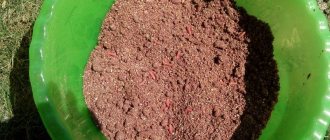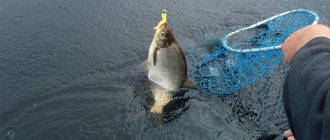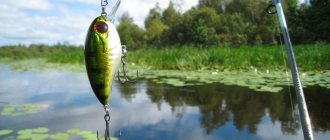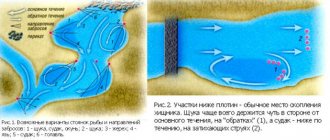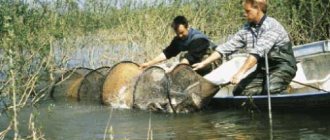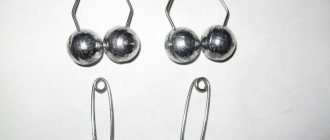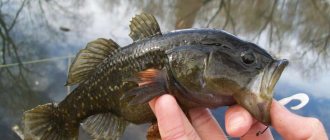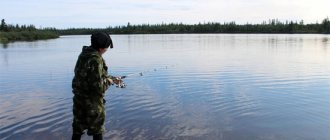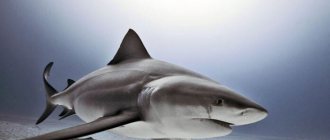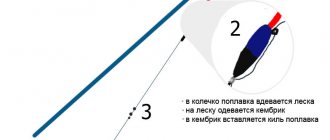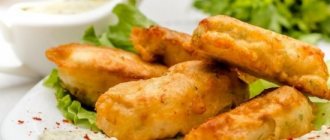Attracting fish to the fishing spot
Photo by the author
Over many years of practice in fishing using bait on a hook, anglers have developed many ways to increase the efficiency of this process. In particular, one of the effective methods of increasing the concentration of fish in a local place, and therefore the biting activity here, is either baiting or baiting. What is the difference between these two approaches?
First you need to decide on the terminology. Bait is considered to be a portioned supply of fish-attracting feed substances (substances) to the place where fishing is planned, and this is done directly during the fishing process. Privada, on the contrary, is served ahead of time, for a long time, and then fishing is organized at this very place. During the fishing process, bait can also be used. On the other hand, if an angler constantly, with short breaks, fishes in the same place with bait, then the selected area of the reservoir can be considered important. Now let’s understand the purposes served by bait and bait.
Bait, with the help of smell and food particles moving in the water, collects fish located near the fishing site, increases its concentration in a small area of the reservoir, increases food competition and, as a result, the activity of the fish.
The bait is used in order to, with the help of “improved nutrition” in a local place, accustom fish that randomly move around the reservoir to regularly, at a certain time, visit the area of the reservoir chosen by the fisherman. The immutable rule of hooking is to throw food at exactly the time at which they then come to fish.
Having understood the terms and purposes, we note that in addition to bait and bait, there are other ways to accumulate fish in a chosen place. Many publications have been devoted to its successful attraction with the help of various objects (snags, branches, bushes, stones, wickerwork, painted balls, transparent vessels with fry, luminous devices, etc.) placed on the bottom of a reservoir or in the water column. In a similar way, both peaceful and predatory fish are collected in a limited area.
Here, for now, we will only talk about attracting fish of the Cyprinidae family with the help of bait and bait, more precisely, such typical peaceful representatives as bream, roach, carp, crucian carp, silver bream, bleak, ide, tench, etc. Naturally, if the bait or bait contains components of animal origin (worms, bloodworms, maggots, shellfish meat, dried blood, etc.), then it will also attract predatory fish, especially juveniles (perch, pike perch, ruff, chub, Zherekhov). In addition, the very noisy crowding of fish around bait in a limited area of a reservoir is clearly audible to large predators even from a great distance, and they will not ignore it.
In the last century, fishing (not commercial fishing!) was the lot of the elite, and in some places it was persecuted as socially harmful, corrupting idleness. Only thanks to our great fishermen S.T. Aksakov and L.P. Sabaneev and the popularization of Western fishing culture, especially English, fishing became a hobby for millions. Therefore, as for bait, today it is used extremely rarely, although at the beginning of the century it was the main way to attract fishing objects. After all, attachment involves a long-term assignment of a place to one fisherman, and with the modern mass of visiting water bodies, especially near large cities, the unauthorized “rental” of a convenient section of the shore causes categorical protests from other fishermen. It is for this reason that our technology for hooking fish has remained at the level of the last century, while an entire industrial complex has grown up around the production of bait.
Now about the composition of baits and baits, depending on the fishing conditions, season and type of fish, about the means of delivering them to the fishing site and about the correct and responsible use of this serious “weapon” by the fisherman. First of all, it is necessary to keep in mind that if it is used thoughtlessly, great harm can be done to the ecology of a reservoir: more than once we have had to deal with a complete lack of bite in an ideal place in all respects, but often visited, “overstayed” by others. This is the result of the activities of “breadwinners” who are excessively generous due to their fishing illiteracy, who carry backpacks full of various cereals and cakes to the reservoir, and go back empty, cursing the lack of fish, bad weather, bad place... Others do not sin with abundant offerings, but even in a standing situation in water they roll the bait into such dense clay balls that it becomes inaccessible to the fish and quickly deteriorates in warm summer water, scaring away all living things around. The same thing happens in the first case - the fish is not able to consume a large amount of food, it is not a pig and knows when to stop.
Baiting, unfortunately, gives the same picture, only here a large amount of food is considered almost a common rule. Although in this case, one or two handfuls of aromatic spice is more than enough. The main thing here is not to feed the fish, but to teach it to “come fishing” at the right time. A simple conclusion follows from the above: it is better to underfeed fish than to overfeed, and the activity of food consumption should be comparable to the rate of digestion, which in summer most depends on the water temperature - the higher it is (in a certain biological range), the more food the fish consumes, and vice versa. To ensure that the rate of feed consumption is close to the rate of its absorption, modern baits are made from carefully ground components. Collecting small particles, the fish slowly fills the intestines, moves a lot, and additionally consumes energy. In addition, some components of bait, especially those containing heavy vegetable oils, in particular oil cakes, or additives of the oil itself (sunflower, corn, rapeseed, burdock, etc.), act on fish as a laxative, as L.P. wrote about .Sabaneev.
In general, in accordance with the biting activity, you need to supply just enough bait and with such frequency that the fish spends the whole fishing time waiting for the next portion of tasty food and the hook with the nozzle would be desirable for it.
I think it is now clear that in terms of their composition, groundbaits and baits should be close to each other, only the technology of their use differs. The structure of both consists of a base and a binder, filled in one ratio or another with nutritional and attractive components. In baits, the production of which is accessible to any angler, the base usually consists of breaded wheat or corn crumbs and bran in a ratio of approximately 3:1. The most accessible binder is oatmeal. If you don’t have it on hand, you can take oatmeal, lightly fry it and grind it in a coffee grinder. The weight of the binder should not exceed 1/3 of the weight of the base, otherwise the bait, when mixed with water, will turn out to be too viscous, will lie on the bottom of the reservoir in a lump and slowly disintegrate into particles, as a result the fish will quickly become saturated and lose interest in your further actions.
Almost all components of bait are of interest to fish, but only those of animal origin (bloodworms, coretra, maggots, worms, etc.) are considered to be feed additives. This also includes a very small number of plant baits, which are introduced into the bait in the summer - with the purpose of “familiarizing” the fish with the bait. Usually these are steamed grains of cereals (barley, wheat, oats, corn) or legumes (peas, lentils, beans, etc.). But if the angler is not stingy and adds bloodworms and maggots to the bait, then the bite on live baits will be much better than on all sorts of cereals, dough and grains. In all bait, the feed component occupies a tenth by weight.
Additives that attract fish include those products that contain large amounts of substances that stimulate the sense of taste (milk powder, egg powder). They usually make up a maximum of a tenth of the whole bait, since, among other things, they have a very strong binding effect. Almost all modern baits are used in combination with flavors of various natures. Of course, the performance of bait and bait depends on how much water you add to the dry bait mixture (this is done immediately before fishing). Too much - then the bait will turn into a dough-like mass, too little - the components will not swell well, and the current will carry them away from the fishing zone.
Very often, it is necessary to introduce ballast - an inert filler - into the composition of groundbait or bait. This is necessary for two reasons: it increases the weight of the bait and “dilutes” its feed part, as a result of which the fish are not satiated so quickly. The ballast should be loose and not interfere with the washout of the bait in the water. Usually it is a river peso
k or fine gravel, less often earth or loam. Only for strong currents are additives with a high clay content suitable, but it is better to add them to the bait in dry, powdered form, and then stir the whole mixture with water - in this case, the bait will be well washed out, and the clay will give a long trail of turbidity that attracts fish.
Anatoly Mailkov July 10, 2012 at 00:00
Selecting a reservoir site
Attachment sites must be chosen carefully. If you start attaching fish in a place that is inconvenient for parking or feeding, there will be no result. River bays with weak currents, exits from pools, and all kinds of turns and bends in rivers are ideal for hooking.
Usually, 3-4 places are chosen for tying, where you had good bites during previous fishing trips. In such places, bait is scattered daily over a fairly small area - 4–6 m2. Subsequently, from these several places, the two most catchy ones are selected. You shouldn’t forget about other places either, but if there’s no bite, it’s better to look for other parts of the river. It is also worth noting that the landing sites should not be too close to each other - this will disorient the fish.
Choosing bait based on the type of fish
You need to prepare bait for fishing taking into account the fish you plan to catch. For example, all types of carp fish love natural animal and plant baits, on which they can be caught throughout the year. In cold water, baits with a high calorie content, bloodworms, worms, and maggots work more effectively. In warm water, vegetable baits are used. To catch predatory fish, as a rule, in the vast majority of cases, bait of animal origin, live bait, bunches of worms, shellfish meat are used, and artificial baits are also used for fishing, the game of which is carried out using a spinning rod.
How to make bait for fish
Fishermen of the last century not only knew perfectly well how to cook, but also how to use bait. Unfortunately, today, as a means of catch fishing, it is almost forgotten. But in vain. Read literature about how old fishermen caught fish. None of them cared for small things. But there are few left who are capable of catching trophy specimens with a stick, hook and line. Yes, and modern fishing gear and methods, if handled skillfully, can simply knock out populations of fish in reservoirs and quite legally.
But let's continue...
Privada is still an effective and, most importantly, budget-friendly way to attract fish. First of all, large, trophy ones, to a specific place of intended fishing.
This is like a foundation for future fishing. By baiting, the fisherman prepares a catchable place for himself. The greatest effect of the bait is achieved precisely on the river in the current, where the predator will not chase the gathered fish, interfering with float and feeder fishing.
Ingredients for fish bait
So, the main ingredients of the bait are root vegetables, cereals and grains, or rather porridge:
- peas (all carp)
- corn (carp, carp, bream, crucian carp, podust)
- pearl barley (bream, white bream, roach, silver bream, ide, chub)
- millet (all carp)
- wheat (white-eye, roach, silver bream, ide, chub)
- potatoes (carp, carp, crucian carp)
- soil (clay, earth)
Additionally, meal, macadamia, hemp, whole and cut animal feed can be added: maggots, worms, bloodworms.
You can combine the bait in any way you like, but no more than 2-3 main ingredients. All grains and root vegetables for seasoning must be boiled.
Along the river, coarse grains work best: corn, peas, pearl barley in balls with clay. It is the large faction that beats off the small change and seizes trophy specimens. Whole steamed peas simply will not fit into the mouth of the roach and silver bream.
In crucian and carp reservoirs with stagnant water - peas, potatoes, millet, corn. Clay and chopped worms and bloodworms are added to the bait along the line.
The proportions of bait are approximately the following: 50-70% clay or earth, 30-50% cereals and grains.
River balls are made only with clay, dense and tightly compressed. It is important that they do not fall apart with the current for as long as possible. The fish will dig into them and gradually catch our grain bait. For standing water in reservoirs and lakes, soil can be used instead of clay. It is advisable to take it from the intended fishing spot.
Start of fishing
After a few days of hooking, you can start fishing. You need to fish at the same time of day (usually at dawn or dawn) when you usually cast your bait. 10–20 minutes before the start of fishing, throw some bait into your preferred spot.
Unlike bait, complementary feeding is carried out just before fishing. The amount of food should not be large, otherwise you will feed the fish so much that it will not be interested in the bait. When the bite weakens, complementary foods are gradually added to the water. If the bite decreases even with regular bait, then it is better to change the place.
Fish Attractors
Attractant substances are not food for fish, they are designed to attract it and whet its appetite. They are added in small doses to bait or used to process the bait directly. These are oriental spices, oils, seeds of umbrella plants, some of them are reflected in the table. Their main goal is to encourage fish to swim to the fishing spot from a long distance.
Table. Popular supplements to attract peaceful fish.
| Additive name | In what form is it used? | Adding to bait | What type of fish is it suitable for? |
| Garlic | Ground dried (infusion) | 2-5% | Bream, carp, (crucian carp) |
| Anise | Powder | 6-8% | Bream, carp, crucian carp, roach |
| Star anise fruit | Ground | 2-5% | Peaceful fish of all kinds |
| Cinnamon | Dried ground | 2-5% | Bream |
| Fennel | Oil | 2-5% | Bream |
| Carob fruit | Ground | 5-10% | Bream, roach |
| Turmeric roots and stems | Ground | 10-15% | Roach |
| Dill | Ground | 4-8% | Bream, tench, roach, crucian carp |
| Basil leaves and seeds | Finely ground | 5-7% | Bream |
| Vanilla | Sugar | 6% | Carp, bream, roach, ide |
The above additives can be mixed to enhance the effect and add versatility to the feeding mixture.
For example, when fishing for bream, cinnamon goes well with coriander, basil, and vanilla. Garlic - with star anise, anise, basil.
Some fragrances can be easily made with your own hands. For example, an infusion of fresh garlic is used for catching crucian carp: knead 2-3 cloves, pour a glass of hot water, and leave for 5-6 hours. The resulting volume is poured into water to mix 1.5-2 kg of bait.
Fruit attractants are widely used. They are presented in the form of clean scents: strawberry, plum, banana, peach; as well as their combinations, are used mainly in the summer.

